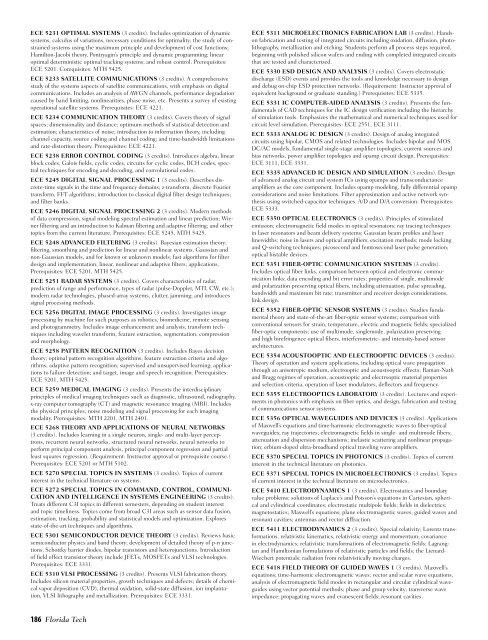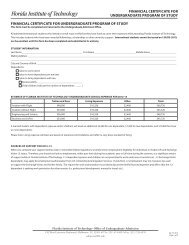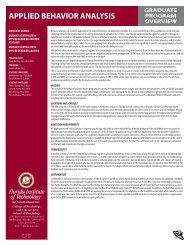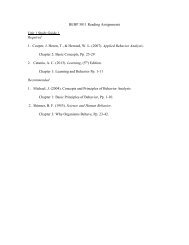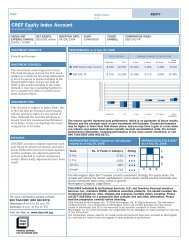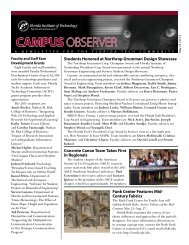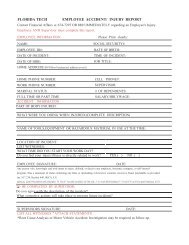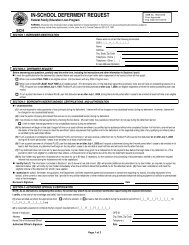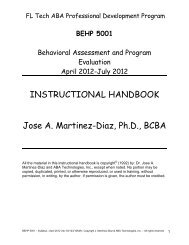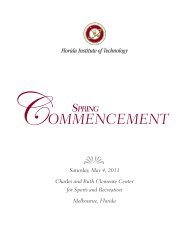2008–2009 - Florida Institute of Technology
2008–2009 - Florida Institute of Technology
2008–2009 - Florida Institute of Technology
You also want an ePaper? Increase the reach of your titles
YUMPU automatically turns print PDFs into web optimized ePapers that Google loves.
ECE 5231 OPTIMAL SYSTEMS (3 credits). Includes optimization <strong>of</strong> dynamic<br />
systems, calculus <strong>of</strong> variations, necessary conditions for optimality; the study <strong>of</strong> constrained<br />
systems using the maximum principle and development <strong>of</strong> cost functions;<br />
Hamilton-Jacobi theory, Pontryagin’s principle and dynamic programming; linear<br />
optimal deterministic optimal tracking systems; and robust control. Prerequisites:<br />
ECE 5201. Corequisites: MTH 5425.<br />
ECE 5233 SATELLITE COMMUNICATIONS (3 credits). A comprehensive<br />
study <strong>of</strong> the systems aspects <strong>of</strong> satellite communications, with emphasis on digital<br />
communications. Includes an analysis <strong>of</strong> AWGN channels, performance degradation<br />
caused by band limiting, nonlinearities, phase noise, etc. Presents a survey <strong>of</strong> existing<br />
operational satellite systems. Prerequisites: ECE 4221.<br />
ECE 5234 COMMUNICATION THEORY (3 credits). Covers theory <strong>of</strong> signal<br />
spaces; dimensionality and distance; optimum methods <strong>of</strong> statistical detection and<br />
estimation; characteristics <strong>of</strong> noise; introduction to information theory, including<br />
channel capacity, source coding and channel coding; and time-bandwidth limitations<br />
and rate-distortion theory. Prerequisites: ECE 4221.<br />
ECE 5238 ERROR CONTROL CODING (3 credits). Introduces algebra, linear<br />
block codes, Galois fields, cyclic codes, circuits for cyclic codes, BCH codes, spectral<br />
techniques for encoding and decoding, and convolutional codes.<br />
ECE 5245 DIGITAL SIGNAL PROCESSING 1 (3 credits). Describes discrete-time<br />
signals in the time and frequency domains; z-transform, discrete Fourier<br />
transform, FFT algorithms; introduction to classical digital filter design techniques;<br />
and filter banks.<br />
ECE 5246 DIGITAL SIGNAL PROCESSING 2 (3 credits). Modern methods<br />
<strong>of</strong> data compression, signal modeling spectral estimation and linear prediction; Wiener<br />
filtering and an introduction to Kalman filtering and adaptive filtering; and other<br />
topics from the current literature. Prerequisites: ECE 5245, MTH 5425.<br />
ECE 5248 ADVANCED FILTERING (3 credits). Bayesian estimation theory;<br />
filtering, smoothing and prediction for linear and nonlinear systems, Gaussian and<br />
non-Gaussian models, and for known or unknown models; fast algorithms for filter<br />
design and implementation; linear, nonlinear and adaptive filters; applications.<br />
Prerequisites: ECE 5201, MTH 5425.<br />
ECE 5251 RADAR SYSTEMS (3 credits). Covers characteristics <strong>of</strong> radar,<br />
prediction <strong>of</strong> range and performance, types <strong>of</strong> radar (pulse-Doppler, MTI, CW, etc.);<br />
modern radar technologies, phased-array systems, clutter, jamming; and introduces<br />
signal processing methods.<br />
ECE 5256 DIGITAL IMAGE PROCESSING (3 credits). Investigates image<br />
processing by machine for such purposes as robotics, biomedicine, remote sensing<br />
and photogrammetry. Includes image enhancement and analysis, transform techniques<br />
including wavelet transform, feature extraction, segmentation, compression<br />
and morphology.<br />
ECE 5258 PATTERN RECOGNITION (3 credits). Includes Bayes decision<br />
theory; optimal pattern recognition algorithms; feature extraction criteria and algorithms;<br />
adaptive pattern recognition; supervised and unsupervised learning; applications<br />
to failure detection; and target, image and speech recognition. Prerequisites:<br />
ECE 5201, MTH 5425.<br />
ECE 5259 MEDICAL IMAGING (3 credits). Presents the interdisciplinary<br />
principles <strong>of</strong> medical imaging techniques such as diagnostic, ultrasound, radiography,<br />
x-ray computer tomography (CT) and magnetic resonance imaging (MRI). Includes<br />
the physical principles, noise modeling and signal processing for each imaging<br />
modality. Prerequisites: MTH 2201, MTH 2401.<br />
ECE 5268 THEORY AND APPLICATIONS OF NEURAL NETWORKS<br />
(3 credits). Includes learning in a single neuron, single- and multi-layer perceptrons,<br />
recurrent neural networks, structured neural networks, neural networks to<br />
perform principal component analysis, principal component regression and partial<br />
least squares regression. (Requirement: Instructor approval or prerequisite course.)<br />
Prerequisites: ECE 5201 or MTH 5102.<br />
ECE 5270 SPECIAL TOPICS IN SYSTEMS (3 credits). Topics <strong>of</strong> current<br />
interest in the technical literature on systems.<br />
ECE 5272 SPECIAL TOPICS IN COMMAND, CONTROL, COMMUNI-<br />
CATION AND INTELLIGENCE IN SYSTEMS ENGINEERING (3 credits).<br />
Treats different C3I topics in different semesters, depending on student interest<br />
and topic timeliness. Topics come from broad C3I areas such as sensor data fusion,<br />
estimation, tracking, probability and statistical models and optimization. Explores<br />
state-<strong>of</strong>-the-art techniques and algorithms.<br />
ECE 5301 SEMICONDUCTOR DEVICE THEORY (3 credits). Reviews basic<br />
semiconductor physics and band theory; development <strong>of</strong> detailed theory <strong>of</strong> p-n junctions;<br />
Schottky barrier diodes, bipolar transistors and heterojunctions. Introduction<br />
<strong>of</strong> field effect transistor theory include JFETs, MOSFETs and VLSI technologies.<br />
Prerequisites: ECE 3331.<br />
ECE 5310 VLSI PROCESSING (3 credits). Presents VLSI fabrication theory.<br />
Includes silicon material properties, growth techniques and defects; details <strong>of</strong> chemical<br />
vapor deposition (CVD), thermal oxidation, solid-state diffusion, ion implantation,<br />
VLSI lithography and metallization. Prerequisites: ECE 3331.<br />
186 <strong>Florida</strong> Tech<br />
ECE 5311 MICROELECTRONICS FABRICATION LAB (3 credits). Handson<br />
fabrication and testing <strong>of</strong> integrated circuits including oxidation, diffusion, photolithography,<br />
metallization and etching. Students perform all process steps required,<br />
beginning with polished silicon wafers and ending with completed integrated circuits<br />
that are tested and characterized.<br />
ECE 5330 ESD DESIGN AND ANALYSIS (3 credits). Covers electrostatic<br />
discharge (ESD) events and provides the tools and knowledge necessary to design<br />
and debug on-chip ESD protection networks. (Requirement: Instructor approval <strong>of</strong><br />
equivalent background or graduate standing.) Prerequisites: ECE 5335.<br />
ECE 5331 IC COMPUTER-AIDED ANALYSIS (3 credits). Presents the fundamentals<br />
<strong>of</strong> CAD techniques for the IC design verification including the hierarchy<br />
<strong>of</strong> simulation tools. Emphasizes the mathematical and numerical techniques used for<br />
circuit level simulation. Prerequisites: ECE 2551, ECE 3111.<br />
ECE 5333 ANALOG IC DESIGN (3 credits). Design <strong>of</strong> analog integrated<br />
circuits using bipolar, CMOS and related technologies. Includes bipolar and MOS<br />
DC/AC models, fundamental single-stage amplifier topologies, current sources and<br />
bias networks, power amplifier topologies and opamp circuit design. Prerequisites:<br />
ECE 3111, ECE 3331.<br />
ECE 5335 ADVANCED IC DESIGN AND SIMULATION (3 credits). Design<br />
<strong>of</strong> advanced analog circuit and system ICs using opamps and transconductance<br />
amplifiers as the core component. Includes opamp modeling, fully differential opamp<br />
considerations and noise limitations. Filter approximation and active network synthesis<br />
using switched-capacitor techniques. A/D and D/A conversion. Prerequisites:<br />
ECE 5333.<br />
ECE 5350 OPTICAL ELECTRONICS (3 credits). Principles <strong>of</strong> stimulated<br />
emission; electromagnetic field modes in optical resonators; ray tracing techniques<br />
in laser resonators and beam delivery systems; Gaussian beam pr<strong>of</strong>iles and laser<br />
linewidths; noise in lasers and optical amplifiers; excitation methods; mode locking<br />
and Q-switching techniques; picosecond and femtosecond laser pulse generation;<br />
optical bistable devices.<br />
ECE 5351 FIBER-OPTIC COMMUNICATION SYSTEMS (3 credits).<br />
Includes optical fiber links, comparison between optical and electronic communication<br />
links; data encoding and bit error rates; properties <strong>of</strong> single, multimode<br />
and polarization preserving optical fibers, including attenuation, pulse spreading,<br />
bandwidth and maximum bit rate; transmitter and receiver design considerations,<br />
link design.<br />
ECE 5352 FIBER-OPTIC SENSOR SYSTEMS (3 credits). Studies fundamental<br />
theory and state-<strong>of</strong>-the-art fiber-optic sensor systems; comparison with<br />
conventional sensors for strain, temperature, electric and magnetic fields; specialized<br />
fiber-optic components; use <strong>of</strong> multimode, singlemode, polarization preserving<br />
and high birefringence optical fibers, interferometric- and intensity-based sensor<br />
architectures.<br />
ECE 5354 ACOUSTOOPTIC AND ELECTROOPTIC DEVICES (3 credits).<br />
Theory <strong>of</strong> operation and system applications, including optical wave propagation<br />
through an anisotropic medium, electrooptic and acoustooptic effects; Raman-Nath<br />
and Bragg regimes <strong>of</strong> operation, acoustooptic and electrooptic material properties<br />
and selection criteria, operation <strong>of</strong> laser modulators, deflectors and frequency.<br />
ECE 5355 ELECTROOPTICS LABORATORY (3 credits). Lectures and experiments<br />
in photonics with emphasis on fiber optics, and design, fabrication and testing<br />
<strong>of</strong> communications sensor systems.<br />
ECE 5356 OPTICAL WAVEGUIDES AND DEVICES (3 credits). Applications<br />
<strong>of</strong> Maxwell’s equations and time-harmonic electromagnetic waves to fiber-optical<br />
waveguides; ray trajectories; electromagnetic fields in single- and multimode fibers;<br />
attenuation and dispersion mechanisms; inelastic scattering and nonlinear propagation;<br />
erbium-doped ultra-broadband optical traveling wave amplifiers.<br />
ECE 5370 SPECIAL TOPICS IN PHOTONICS (3 credits). Topics <strong>of</strong> current<br />
interest in the technical literature on photonics.<br />
ECE 5371 SPECIAL TOPICS IN MICROELECTRONICS (3 credits). Topics<br />
<strong>of</strong> current interest in the technical literature on microelectronics.<br />
ECE 5410 ELECTRODYNAMICS 1 (3 credits). Electrostatics and boundary<br />
value problems; solutions <strong>of</strong> Laplace’s and Poisson’s equations in Cartesian, spherical<br />
and cylindrical coordinates; electrostatic multipole fields; fields in dielectrics;<br />
magnetostatics; Maxwell’s equations; plane electromagnetic waves; guided waves and<br />
resonant cavities; antennas and vector diffraction.<br />
ECE 5411 ELECTRODYNAMICS 2 (3 credits). Special relativity; Lorentz transformations,<br />
relativistic kinematics, relativistic energy and momentum; covariance<br />
in electrodynamics; relativistic transformations <strong>of</strong> electromagnetic fields; Lagrangian<br />
and Hamiltonian formulations <strong>of</strong> relativistic particles and fields; the Lienard-<br />
Wiechert potentials; radiation from relativistically moving charges.<br />
ECE 5418 FIELD THEORY OF GUIDED WAVES 1 (3 credits). Maxwell’s<br />
equations; time-harmonic electromagnetic waves; vector and scalar wave equations,<br />
analysis <strong>of</strong> electromagnetic field modes in rectangular and circular cylindrical waveguides<br />
using vector potential methods; phase and group velocity; transverse wave<br />
impedance; propagating waves and evanescent fields; resonant cavities.


